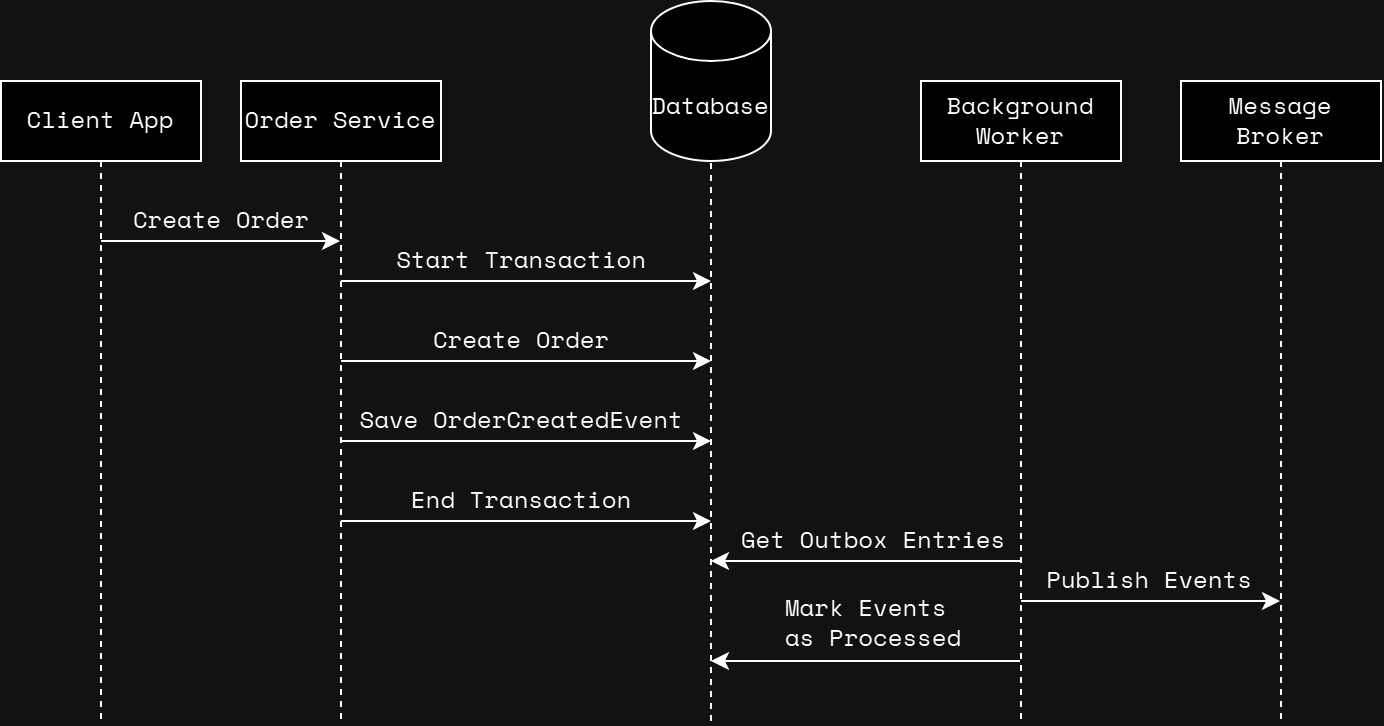Prerequisites
To understand this topic fully, familiarity with transactions, microservices, event-driven architecture, and idempotency is recommended.
Here are some of my previous blog posts that will be useful:
- Maintain Database Consistency With Transactions
- Microservice Orchestration vs. Choreography
- Scalability With Asynchronous Messaging
- Idempotency is Important
Introduction
With a microservice architecture, it is very common to do something like the following:
- Create/update/delete an entity.
- Publish an event to a message broker.
For instance, consider an e-commerce system. Every time we create an Order via the OrderService,
we also publish an OrderCreatedEvent so that related services can react accordingly.
Some examples of services that must perform an action when an OrderCreatedEvent is received:
InventoryServiceneeds to update its inventory data.EmailServicesends a confirmation email to the customer.
It's likely we have some code like the following:
/**
* Some pseudocode to illustrate creating a new order via the OrderService.
*/
// Step 1
Database.CreateOrder(orderInfo);
// Step 2
MessageBroker.Publish(new OrderCreatedEvent(orderInfo));/**
* Some pseudocode to illustrate creating a new order via the OrderService.
*/
// Step 1
Database.CreateOrder(orderInfo);
// Step 2
MessageBroker.Publish(new OrderCreatedEvent(orderInfo));Problem
However, like we have discussed in my previous blog posts, things can fail! Suppose the following occurs:
-
✔️
Orderis created successfully. -
❌ Failure to send the
OrderCreatedEvent.
// ✔️ Step 1
Database.CreateOrder(orderInfo);
// ❌ Step 2
MessageBroker.Publish(new OrderCreatedEvent(orderInfo));// ✔️ Step 1
Database.CreateOrder(orderInfo);
// ❌ Step 2
MessageBroker.Publish(new OrderCreatedEvent(orderInfo));
Although it might appear as though the Order was created, the OrderCreatedEvent has actually been lost.
As a result, the InventoryService would not update its inventory data,
and the EmailService would not send the confirmation email to the user.
For mission-critical workflows, this can have serious implications!
Solution: The Outbox Pattern
The Outbox pattern addresses this problem, via two main components:
- Persisting events with transactions.
- Background worker to publish events.
The overall process is outlined by the sequence diagram below:

Let's explore these concepts a bit further.
Persisting Events With Transactions
First and foremost, events are persisted in the database, leveraging a transaction.
/**
* Modified pseudocode leveraging the Outbox pattern.
*/
Database.StartTransaction();
Database.CreateOrder(orderInfo);
Database.PersistEvent(new OrderCreatedEvent(orderInfo));
Database.EndTransaction()/**
* Modified pseudocode leveraging the Outbox pattern.
*/
Database.StartTransaction();
Database.CreateOrder(orderInfo);
Database.PersistEvent(new OrderCreatedEvent(orderInfo));
Database.EndTransaction()As illustrated by the pseudocode above, the two operations now execute atomically to ensure data consistency.
Background Worker to Publish Events
The background worker periodically queries the persisted events (referred to as the "outbox" entries), publishes them to the message broker, and then marks them as processed. This process can be accomplished via polling.
Considerations
Below are a few considerations that are important to keep in mind when implementing the Outbox pattern.
- Order of publishing: Events must be sent in the same order in which the service updates the database.
For example,
OrderUpdatedshould not be published before anOrderCreatedevent. - Idempotent consumers: It is good practice to ensure that consumers are idempotent. In the case that duplicate messages are published, there would be no impact.
Conclusion
- Events are persisted in the database alongside the create/update/delete of an entity, leveraging a transaction.
- A background worker is responsible for polling the events persisted in the database, publishing to a message broker, and finally marking the events as processed.
- The Outbox pattern improves the reliability of a system given that events will not be lost.


